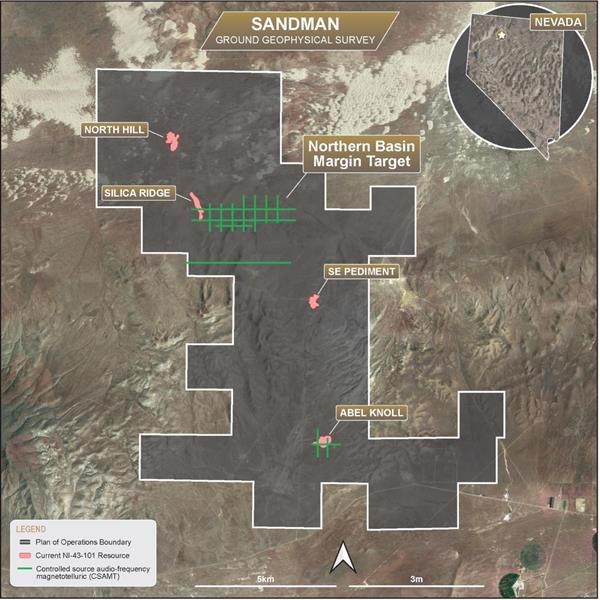Recently, Gold Bull Resources reported that it will begin a geophysical survey, known as a Controlled Source Audio Magnetotellurics (CSAMT), within its 100% owned Sandman Project situated in Humboldt County, Nevada, United States.
 CSAMT survey lines with current Mineral Resource Estimate outlines and Plan of Operations boundary. Image Credit: Gold Bull Resources Corp.
CSAMT survey lines with current Mineral Resource Estimate outlines and Plan of Operations boundary. Image Credit: Gold Bull Resources Corp.
Highlights and Update:
- Ground Geophysics is demonstrating to be an efficient method for targeting mineralization undercover at Sandman
- CSAMT can spot resistivity contrasts in the rocks under the surface, which would help in outlining and ranking significant drill targets
- Drill program scheduled to begin upon receipt of geophysical data – Q4 2021
Areas prospective for gold within the Sandman project are extensively covered by wind-blown sand, concealing the geological indicators of mineralizing processes we might otherwise observe at surface. We are drawing on the management team’s experience applying surface geochemistry and geophysics to covered terrains in Australia and Africa.
David Johnson, Vice President - Exploration, Gold Bull
He added, “Orientation lag geochemical sampling over the Silica Ridge deposit provided encouragement that the technique can work in this setting, and analysis of the drill hole geochemical data from the Sandman deposits aids our understanding of pathfinder element associations. CSAMT is a proven geophysical technique in epithermal gold exploration, particularly in Nevada.”
We are integrating these new datasets with existing geological mapping, drilling, ground and airborne geophysical surveys, using our understanding of epithermal mineral systems and orientation over known deposits at Sandman. Our current exploration model, discussed in the recent press release, is focused on the search for a world-class gold orebody.
David Johnson, Vice President - Exploration, Gold Bull
Background
DIAS Geophysical of Saskatoon SK has begun a CSAMT survey within the Sandman project, beginning with a set of north-south oriented traverses spanning a target zone east of the Silica Ridge deposit.
Reconnaissance surface geochemical sampling, using a technique similar to lag sampling of desert deflation pavement material (refer to Carver, R., Chenoweth, L.M., Mazzucchelli, R., Oates, C.J., & Robbins, T. 1987. “Lag” — a geochemical sampling medium for arid regions Journal of Geochemical Exploration, 28, 183-199), has delivered promising preliminary results, and infill sampling will be conducted before the conclusion of the CSAMT survey.
CSAMT lines are also scheduled to span across the Abel Knoll deposit, to help the scheduling of drilling to follow up the intersection of 90 m (295 ft) at 0.6 g/t Au from 76.2 m (250 ft) in hole SA-0031 (refer to press release “Gold Bull reports significant new gold mineralization outside of current resource at Sandman including: 90 m at 0.6 g/t Au” dated July 28, 2021).
CSAMT surveying is an electromagnetic method exploiting naturally occurring EM waves spreading in the waveguide created by the magnetosphere and the Earth’s surface. The EM waves are triggered by regional and global lightning strikes and when the solar wind interacts with the Earth’s magnetosphere.
Dispersing of the EM waves by structures within the Earth create perturbations in the time-varying magnetic and electric fields measured at the surface, which can be numerically processed to produce images of those structures. These can then be interpreted to establish the locations of faults that may have served as channels for mineralizing hydrothermal fluids.
For instance, the boundary between the Triassic metasedimentary basement rocks and the overlying Tertiary volcanic and volcaniclastic sequence is the locus of a robust contrast in electrical resistivity, which is easily imaged using CSAMT. Faults offsetting the Triassic-Tertiary contact are prospective areas for gold mineralization.
Furthermore, adularia alteration of the Tertiary rocks, frequently related to gold mineralization, transmits high electrical resistivity, contrasting robustly with the argillic and propylitic altered, more electrically conductive country rocks. Historic CSAMT data compiled over the established deposits at Sandman offers practical orientation data on this geophysical method.
Next Steps
Targets detected by inferring the CSAMT geophysical data along with “lag” geochemical sampling data will be analyzed as part of the drilling program scheduled for this winter.